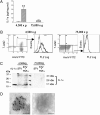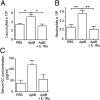Sterile inflammation of endothelial cell-derived apoptotic bodies is mediated by interleukin-1α
- PMID: 22143786
- PMCID: PMC3251090
- DOI: 10.1073/pnas.1116848108
Sterile inflammation of endothelial cell-derived apoptotic bodies is mediated by interleukin-1α
Abstract
Sterile inflammation resulting from cell death is due to the release of cell contents normally inactive and sequestered within the cell; fragments of cell membranes from dying cells also contribute to sterile inflammation. Endothelial cells undergoing stress-induced apoptosis release membrane microparticles, which become vehicles for proinflammatory signals. Here, we show that stress-activated endothelial cells release two distinct populations of particles: One population consists of membrane microparticles (<1 μm, annexin V positive without DNA and no histones) and another larger (1-3 μm) apoptotic body-like particles containing nuclear fragments and histones, representing apoptotic bodies. Contrary to present concepts, endothelial microparticles do not contain IL-1α and do not induce neutrophilic chemokines in vitro. In contrast, the large apoptotic bodies contain the full-length IL-1α precursor and the processed mature form. In vitro, these apoptotic bodies induce monocyte chemotactic protein-1 and IL-8 chemokine secretion in an IL-1α-dependent but IL-1β-independent fashion. Injection of these apoptotic bodies into the peritoneal cavity of mice induces elevated serum neutrophil-inducing chemokines, which was prevented by cotreatment with the IL-1 receptor antagonist. Consistently, injection of these large apoptotic bodies into the peritoneal cavity induced a neutrophilic infiltration that was prevented by IL-1 blockade. Although apoptosis is ordinarily considered noninflammatory, these data demonstrate that nonphagocytosed endothelial apoptotic bodies are inflammatory, providing a vehicle for IL-1α and, therefore, constitute a unique mechanism for sterile inflammation.
Conflict of interest statement
The authors declare no conflict of interest.
Figures





Similar articles
-
Differential release of chromatin-bound IL-1alpha discriminates between necrotic and apoptotic cell death by the ability to induce sterile inflammation.Proc Natl Acad Sci U S A. 2010 Feb 9;107(6):2574-9. doi: 10.1073/pnas.0915018107. Epub 2010 Jan 25. Proc Natl Acad Sci U S A. 2010. PMID: 20133797 Free PMC article.
-
Platelet interleukin-1alpha drives cerebrovascular inflammation.Blood. 2010 Apr 29;115(17):3632-9. doi: 10.1182/blood-2009-11-252643. Epub 2010 Mar 3. Blood. 2010. PMID: 20200351
-
Pure Hemozoin is inflammatory in vivo and activates the NALP3 inflammasome via release of uric acid.J Immunol. 2009 Oct 15;183(8):5208-20. doi: 10.4049/jimmunol.0713552. Epub 2009 Sep 25. J Immunol. 2009. PMID: 19783673 Free PMC article.
-
The Interleukin-1 Family.Adv Exp Med Biol. 2016;941:21-29. doi: 10.1007/978-94-024-0921-5_2. Adv Exp Med Biol. 2016. PMID: 27734407 Review.
-
Interleukin-1α.Semin Immunol. 2013 Dec 15;25(6):430-8. doi: 10.1016/j.smim.2013.10.005. Epub 2013 Nov 1. Semin Immunol. 2013. PMID: 24183701 Review.
Cited by
-
Osteoclast-derived apoptotic bodies show extended biological effects of parental cell in promoting bone defect healing.Theranostics. 2020 May 22;10(15):6825-6838. doi: 10.7150/thno.45170. eCollection 2020. Theranostics. 2020. PMID: 32550906 Free PMC article.
-
Emerging understanding of apoptosis in mediating mesenchymal stem cell therapy.Cell Death Dis. 2021 Jun 9;12(6):596. doi: 10.1038/s41419-021-03883-6. Cell Death Dis. 2021. PMID: 34108448 Free PMC article. Review.
-
Biological properties of extracellular vesicles and their physiological functions.J Extracell Vesicles. 2015 May 14;4:27066. doi: 10.3402/jev.v4.27066. eCollection 2015. J Extracell Vesicles. 2015. PMID: 25979354 Free PMC article.
-
Extracellular Vesicles and Acute Kidney Injury: Potential Therapeutic Avenue for Renal Repair and Regeneration.Int J Mol Sci. 2022 Mar 30;23(7):3792. doi: 10.3390/ijms23073792. Int J Mol Sci. 2022. PMID: 35409151 Free PMC article. Review.
-
Detection and Isolation of Apoptotic Bodies to High Purity.J Vis Exp. 2018 Aug 12;(138):58317. doi: 10.3791/58317. J Vis Exp. 2018. PMID: 30148494 Free PMC article.
References
-
- Zitvogel L, Kepp O, Kroemer G. Decoding cell death signals in inflammation and immunity. Cell. 2010;140:798–804. - PubMed
-
- Rider P, et al. IL-1alpha and IL-1beta recruit different myeloid cells and promote different stages of sterile inflammation. J Immunol. 2011;187:4835–4843. - PubMed
-
- Dinarello CA. Immunological and inflammatory functions of the interleukin-1 family. Annu Rev Immunol. 2009;27:519–550. - PubMed
-
- Kurt-Jones EA, Fiers W, Pober JS. Membrane interleukin 1 induction on human endothelial cells and dermal fibroblasts. J Immunol. 1987;139:2317–2324. - PubMed
Publication types
MeSH terms
Substances
Grants and funding
LinkOut - more resources
Full Text Sources
Other Literature Sources
Molecular Biology Databases
Research Materials

